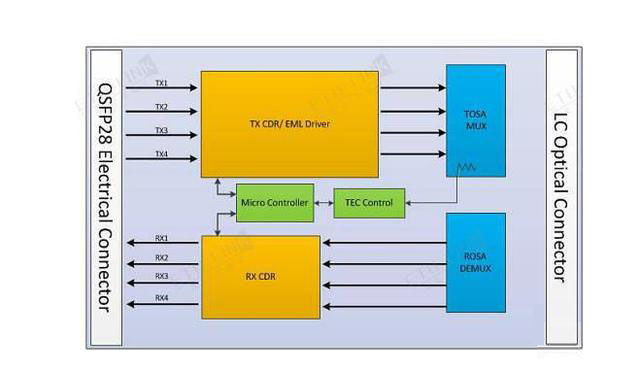

 Knowledge Base +
Knowledge Base +  2023.11.29
2023.11.29The advancement of technology and the rapid development of data centers have led to a growing demand for high-speed optical communication modules. 100G QSFP28 ER4 optical modules, as a new type of high-speed optical communication module, are gradually gaining widespread attention. In the previous issues, we have learned about 40G ER4 series optical modules.
Now, this post will introduce the module with a 40km transmission distance-100GBASE ER4, from the perspectives of definition, design, and design of the module, we will introduce the module with a 40km transmission distance-100GBASE ER4, which can be used for high-speed optical communication.
100G QSFP28 ER4 Optical Module Product Information

100G QSFP28 ER4 Optical Module Working Principle
The 100G QSFP28 ER4 Optical Module is a 100Gb/s module designed for Ethernet 100G BASE-ER4 compliant optical communication applications.The 100G QSFP28 ER4 Optical Module utilizes a QSFP28 Multi-Source Agreement (MSA) compliant form factor and supports DDM digital diagnostics. It is designed to meet the harshest external operating conditions, including temperature, humidity, and EMI interference.
The module converts four 25Gb/s electrical data inputs into four LAN WDM optical signals, which are then multiplexed into a single 100Gb/s optical transmission. Conversely, at the receiving end, the module demultiplexes the 100Gb/s optical input into four LAN WDM optical signal channels, which are then converted into four electrical output channels.

The center wavelengths of the four LAN WDM channels are 1295nm, 1300nm, 1304nm, and 1309nm. The high-performance cooled DFB transmitter and high-sensitivity APD receiver provide excellent performance for 100G Ethernet applications, with up to a 30km link without the use of an FEC, and up to a 40km link with the use of an FEC.
III. 100G QSFP28 ER4 Optical Module Features and Application Scenarios
High-speed transmission: 100Gbps transmission rate makes it ideal for processing large amounts of data and connecting different devices and servers, especially in data centers, cloud computing and other fields.
Long Distance Transmission: ER stands for "Extended Range" which means that it can transmit stably over long distances, usually up to 40 kilometers, which has significant advantages in long distance communication environments, such as in optical backbone networks, and also meets the needs of modern cities for communication speed.
Low power consumption: Compared with traditional optical modules, 100G QSFP28 ER4 optical modules usually have lower power consumption, which has a positive effect on energy saving and emission reduction.
Compatibility: 100G QSFP28 ER4 optical module it can be compatible with a variety of optical fibers and connection methods, making its application in different environments more flexible and diverse.
Q1: What is the difference between QSFP28 ER4 and QSFP28 ER4 Lite Module?
A: The QSFP 100G ER4 has a series of BER requirements of better than 1E-12 without FEC optical modules. However, the receiving sensitivity of 100G QSFP28 ER4 is not satisfied with the existing APD technology. Therefore, many optical module manufacturers/suppliers defined a non-standard 100Gbase ER4 Lite module with a QSFP28 package where the largest transmission distance is up to 40km with FEC or 30km without FEC. FS provides the QSFP28 100G ER4 Lite module compliant with the Ethernet 100Gbase ER4 Lite standard to meet the harshest external operating conditions including temperature, humidity, and EMI interference.
Q2: How does the QSFP 100G ER4 Module differ from the QSFP28 4WDM?
A: The QSFP 100G ER4 optical transceiver supports dual 100G Ethernet applications while the 100G QSFP28 4DWM only supports 100G Ethernet applications. The commons and differences are listed below.
| Form Type | QSFP28 ER4 | QSFP28 4WDM | ||
|---|---|---|---|---|
| Max Data Rate | 25.78125Gbps/27.95Gbps | 25.78125Gbps | ||
| Max Cable Distance | 40km | 10km | 20km | 40km |
| Center Wavelength | 1295.56nm, 1300.05nm, 1304.58nm, 1309.14nm | 1271nm, 1291nm, 1311nm, 1331nm | 1295.56nm, 1300.05nm, 1304.58nm, 1309.14nm | 1295.56nm, 1300.05nm, 1304.58nm, 1309.14nm |
| FEC Requirement | Without FEC (BER 1E-12) | With FEC (BER 5E-5) | ||
| Receiver | SOA+PIN ROSA | PIN ROSA | PIN ROSA | APD ROSA |
| Cooling Requirement | Cooled | Uncooled | Cooled | Cooled |
A: The main difference between 100GBASE ER4 and 100G SR10 is the transmission distance and fiber cables they operate on. The former supports 40km transmission over single-mode fibers through LC connectors, facilitating the development of high-capacity and compact 100G optical equipment used to connect data centers and metro networks. The latter supports link lengths of 100m and 150m respectively on laser-optimized OM3 and OM4 multifiber cables terminated with MPO/MTP-24 connectors. 100G SR10 can also be applied for 10x10 Gigabit Ethernet mode along with ribbon to duplex fiber breakout cables for connectivity from a 100G interface to ten 10G SR optical interfaces.
In summary, as a high-performance optical module, 100G QSFP28 ER4 optical module is gradually becoming a popular choice in the field of optical communication, and its high-speed, long-distance transmission and other characteristics make it play an important role in data centers, metropolitan area network connectivity, long-distance communication and other scenarios, and it also provides a strong support for high-speed data transmission in the digital era.
Subscribe to the newsletter
for all the latest updates.
2-5# Building, Tongfuyu Industrial Zone, Aiqun Road, Shiyan Street, Baoan District, Shenzhen. China
